Yes, I was able to test paddle it for about 15 minutes in a small lake with some stiff wind gusts buffeting me. The test paddle convinced me to buy it. With a 27 inch waterline, a 6.8 L/W ratio (as computed by Charlie Wilson) and a 2"/1" rocker line, it glides well and seems to be noticeably faster than the average touring/tripping canoe.
The elliptical bottom, soft chines and significant tumblehome give it solid initial stability. I didn't try shifting from a kneeling to sitting position, but I'm confident that one can sit in it with confidence. With no protective (or change of) clothing in the cold air and water conditions, I was reluctant to test the secondary stabilty very far, but it was very solid at about a 35° heel.
It doesn't turn as easily as a Wildfire, which has a 2.5"/2.5" rocker line, and I didn't expect it to, but it turns very satisfactorily for a lake-oriented touring canoe. I'm sure it would turn better with a more aggressive heel. It's not a whitewater design, so I personally wouldn't take it on more than class 1+ rapids.
The moderate depth sheer line (unlike my SRT) and the lack of upswept ends (unlike traditional wood/canvas canoes or modern Prospector models such as Swift's) made it well-behaved in the the wind gusts I experienced.
I communicated with @RPATCH about the Keewaydin 15's handling ability. He took a fully loaded one down 700 miles of the Yukon River last summer with @NikonF5user. He said: "it punched above its pay grade in all respects from Lake Laberge with rear quarters breaking rollers to Five Finger Rapids and consistent head winds. It's quite efficient to paddle."
I'll give a more informed review when I have a few hours in the boat.
This is the more informed review of my new-to-me 2021 Swift Keewaydin 15 in carbon fusion layup with champagne gel coat on the bottom.
As shown before, here is my Keewaydin 15 after I brought it home a few days before Christmas 2024, posing before my Japanese red pine tree (pinus densiflora). The canoe was kept in excellent condition by the seller and has not a scratch upon it.
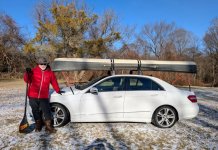
Weather conditions plunged to very cold and windy after Christmas. Yet, so eager was I to paddle the canoe and further to test its performance, I couldn't wait for warmer weather. So, I went out for four local day paddles between New Year's Eve and January 10 before the waters completely froze over. Given my age and relatively poor cardio and muscular conditions, and the extremely cold, windy and even snowy winter conditions, I ended up trying and buying a new paddling wardrobe to protect myself in the winter of my years. I'll detail the evolution of that winter wardrobe in a later thread.
No other human beings (homo sapiens sapiens) were stupid enough to be on the waters in these conditions, so it was just me and Kee, now for thee.
Two of my trips were downstream on the Housatonic River, through the legendary Lovers Leap Gorge, and into Lake Lillinonah.
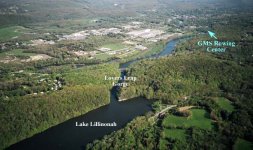
Lovers Leap Gorge is named after Princess Lillinonah of the Pootatuck tribe and her white lover, whom she had once nursed to health, in the mid-1600s. He left her for a year, and she was so heartbroken that she canoed though the gorge toward the rapids. Her lover, who had just returned, saw her from the top of the gorge and leaped off a precipice to save her. But he upset the canoe and they both plunged to their death over a waterfall (now all flooded by damming). So they say.
On my first trip on this route it was not too windy but was too cold for my wardrobe. (Cue Amazon overnight delivery.) Ice was forming in the quiet water near the farm that greets one when emerging into Lake Lillinonah from the gorge.

As I approached closer to the farm, I noticed that the flag was not wind-rippling.
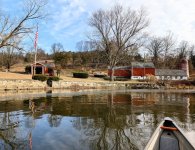
The slack wind gave me confidence to paddle a mile further south on the lake, hugging as close to the shore as the icing waters would permit. I did a crossing on my way back north and saw two swans fishing at the entrance to the gorge.
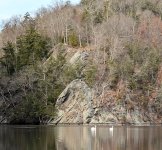
There is always a swift current in the gorge, which requires upstream attainment and the use of eddies along the gorge walls. The Keewaydin sliced up the current faster and more efficiently than my Bell Wildfire, Hemlock SRT or Lotus Caper, and a lot faster than my pudgy Nova Craft Bob Special. It also ferried easily across the gorge current to catch eddies on the right and left sides of the gorge. Nice!
The lack of wind and waves also gave me confidence to shift from my kneeling position, which I still use 95% of the time, to various sitting positions. The Keewaydin 15 felt solid and stable in a one-leg-forward position, a two-leg-forward seated position, and a cross-leg seated position. With its 27" waterline, the Kee felt a bit more stable when seated than my (26.5") Wildfire and noticeably more so than my roundish-bottom (26") SRT. But, at first, I was a bit discomfited when I sat in a cross-leg position.
Why would that be? It was because of the substantial Dave Yost bubble-sided tumblehome, which gives the Kee 15 a maximum width of 29.5" but a gunwale width of only 25.5". Take a look at its side profile:
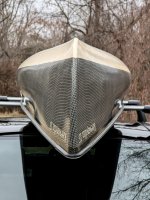
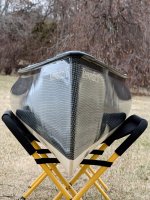
At first, I was annoyed that my knees would bump into the narrow gunwales when I sat cross-legged. However, I soon realized I could lower my knees just a bit and wedge my thighs underneath the tumble-curves of the inwales. By doing this, I was able to lock myself into a solid five-point paddling position: butt on seat, two thighs wedged under gunwales, and two crossed feet pressed against the bottom of the hull. Nice!
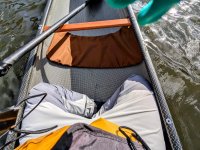
On my second trip on this route, it was much colder and dangerously windy: 24° F (-5° C) with a wind chill of about 10° F (-12° C). It was so windy that I was afraid to take my paddle out of the water to use my camera, so I took no pictures of this trip.
The wind was howling mainly southward and accelerated into confused vortices in the gorge. Mainly just rudding and bracing to maintain steerage and balance, I shot through the gorge like a projectile from a rail gun. Emerging into the lake, I was immediately greeted by confused and changeling wind gusts and pounding waves that desperately wanted to push me around or dump me. The relatively low sheer line of the Keewaydin 15 (19" x 12.5" x 16") helped shed the wind and I was able to maintain control with my 57" ZRE straight paddle.
However, this was no time to be touring Lake Lillinonah. All I wanted to do was not swim in this lonely, freezing lake and to get the heck back to the put-in. So, I turned around to paddle back upstream through the biting wind tunnel of the gorge.
What an ordeal! I literally feared for my life! 80 years old, out of cardio and muscular shape, fighting current and bitter cold vortices of wind buffeting me from the front and ever-changing sides. Take a look at the gorge in calm and warm weather:
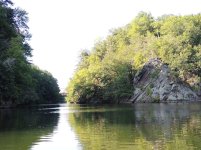
Now imagine 35 mph (56 kmh) freezing cold wind gusts funneling through and bouncing randomly off these craggy, vertical walls.
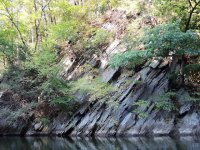
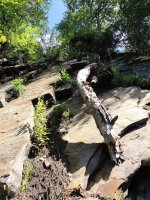
Using ancient whitewater skills, I ferried right and left across the gorge in attempts to reach the lee of wall eddies, only to be scooped out of the transient wind eddies by unpredictable, swirling changes in wind direction, which often tried to slam me into the rocky walls. I couldn't stop paddling for fear of being blown out of control back to the lake. Yet, I was at the limit of my endurance . . . and . . . even more scary . . . was in increasing pain and numbness from the biting cold wind.
Obviously, I made it . . . but just barely. The sleek waterline, wind-shedding sheer line and fast 6.8 L/W ratio of the Keewaydin 15 were helpful assets, as was the 2"/1" differential rocker, which helped pin the stern for enhanced wind control. I don't think I could have made it up the gorge in those conditions in any of my other solo canoes, and certainly not soloing any tandem canoe, especially bow seat backwards.
Tangent: A double paddle may have made the gorge ordeal a bit easier, but that's not what I like or what I ever do. I take great pride and get great satisfaction from controlling a canoe in any conditions, even at my age, with a combination of single-sided correction strokes and timely hit & switch paddling.
After that second gorge trip it was time again to cue Amazon overnight delivery for warmer clothes, and time for a change of waters.
My second two trips were both on New Milford Bay of Candlewood Lake, which is Connecticut's largest lake and also the largest lake within 60 miles of New York City. I put in at the New Milford town beach at Lynn Deming Park and paddled to and from Birch Point Cove and north to the dam.
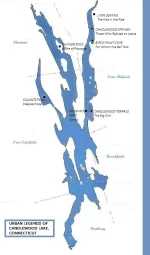
My first trip on Candlewood was the warmest day of the four, perhaps about 40° F (4° C), and was relatively uneventful. I didn't take many pictures. Here, I'm returning back north along the eastern shore in what was a pleasant paddle:
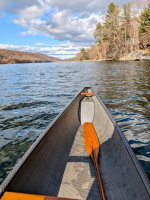
It's interesting that, even at my age and in my condition, I can more effortlessly and tirelessly paddle at a walking pace than I can actually walk at that pace. Whatever.
The more interesting day on Candlewood Lake was the second day because it was snowing. Gently. Quietly. Lovely. Robert Frost-ian.
I illegally parked as close to the vacant beach as I could. I have no problem lifting and carrying the 28 lb. Keewaydin 15 to and from the car on my shoulders, using the curved solo seat as a portage yoke. Placing the canoe on the snowy beach, I'm ready to go south down the bay.
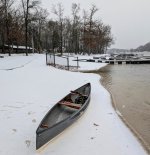
I didn't want to cross to the far shore because New Milford Bay is the deepest part of Candlewood Lake, immediately plunging to a depth of 85 feet (26 meters). Glenn doesn't want to risk swimming in deep waters after the Lovers Leap Gorge ordeal a few days earlier. So, again, I stay near the eastern shore and look at the mostly summer habitations.
What's that sign on the dock up ahead?
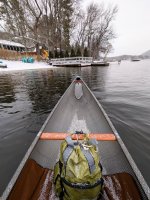
Uh, oh, no life guard is on duty at the private beach. Good thing I'm staying away from the deep waters.

I liked the boat rack at this house with the paddlers and wading bird (blue heron? crane? stork?) etched in the wrought iron balustrade.
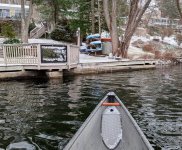
Returning, I enjoyed the beads of ice forming on the tips of branches where they touched the water.
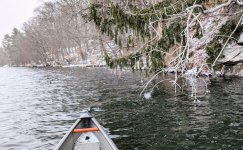
All in all, my fourth day trip in the Keewaydin 15 was an endorphin joy, and a warm one in my final wardrobe.
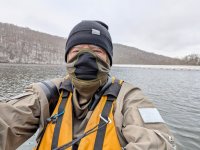
Ciao, snowy beach. I'll see you later in the year when I try to paddle the entire length of Candlewood Lake.
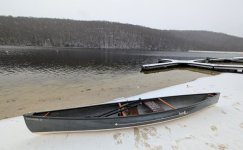
I'll finish with a technical review point about the Swift Keewaydin 15. The bubble-sided tumblehome chine fits very nicely into the concave shoulder curve of a tulip-shaped ZRE carbon racing paddle. Note how the tulip shape curves under the hull and gets close to the keel line.
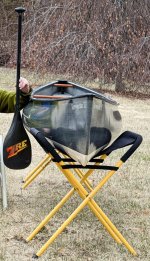
The edge of an ottertail paddle, in contrast, is further away from the keel line because it doesn't extend as far laterally under the hull. This will cause the canoe to yaw more with an animal tail paddle than a tulip-shape paddle.
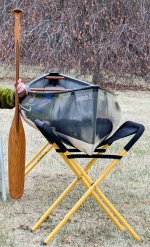
Also, the center of water pressure on an animal tail paddle is much vertically deeper than that of a racing paddle. This means the animal tail paddle must transit a deeper and longer underwater arc than a racing paddle to move the canoe the same distance. Hence, the racing paddle is more efficient. But that detail may not matter to many recreational paddlers, nor to me on many days. The Swift Keewaydin 15 paddles elegantly with all the bent and straight paddles I tried.
I recommend this canoe for efficient lake and quiet river paddling—and, of course, for very lightweight ease of portaging. With my whitewater experience, I'd probably take it on an easy class 2 rapid as long as it isn't bony or scratchy, but I wouldn't expect the Kee 15 to turn like a more highly rockered, symmetrical hull.
